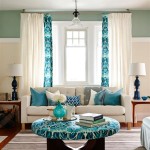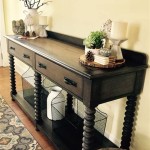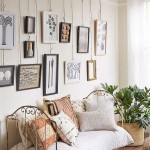Farmhouse Retro Decorating Ideas
Farmhouse retro decor represents a fusion of rustic charm and mid-century modern design. This style blends the simplicity and functionality of farmhouse aesthetics with the vibrant colors, geometric patterns, and playful materials characteristic of the retro era, typically encompassing the 1950s, 1960s, and 1970s. The result is a warm, inviting, and visually interesting space that feels both nostalgic and contemporary.
Achieving a successful farmhouse retro look requires a carefully curated mix of elements. It is not merely about throwing a few vintage items into a farmhouse-style room. Instead, it involves understanding the core principles of both styles and finding the right balance to create a cohesive and harmonious environment. This includes selecting appropriate color palettes, furniture pieces, textiles, and decorative accessories that complement each other and evoke the desired atmosphere.
Color Palette Considerations
Color is a fundamental aspect of farmhouse retro décor. While traditional farmhouse styles often lean towards neutral tones like whites, creams, and grays, the retro influence introduces a broader spectrum of colors. These include the pastels of the 1950s, such as mint green, baby blue, and pale pink, as well as the bolder, earthier tones of the 1960s and 1970s, like avocado green, mustard yellow, burnt orange, and warm browns. Using these colors effectively involves strategic placement and balance.
One approach is to use neutral farmhouse colors as a base for the walls, flooring, and larger furniture pieces, and then introduce retro colors through accent pieces like throw pillows, rugs, artwork, and decorative objects. For instance, a living room with white walls and a natural wood floor could feature a mustard yellow sofa, avocado green curtains, and patterned throw pillows incorporating oranges, browns, and creams. Alternatively, you can opt for a more daring approach by painting an accent wall in a bold retro color or using patterned wallpaper with a vintage-inspired design.
Another technique is to use color blocking, a popular design trend in the retro era, which involves pairing contrasting colors in distinct blocks to create a visually striking effect. This could be achieved by painting kitchen cabinets in different colors or using geometric patterns on walls or floors. The key is to ensure that the colors work together harmoniously, creating a sense of balance and visual appeal. It is advisable to test color combinations before committing to them, using paint samples or digital design tools to visualize the final result.
Furniture Choices: Blending Old and New
Furniture plays a crucial role in defining the character of a farmhouse retro space. The ideal approach is to blend vintage or vintage-inspired pieces with modern farmhouse elements. This creates a sense of authenticity and visual interest, while also ensuring comfort and functionality. When selecting furniture, it is essential to consider the materials, shapes, and styles that were prevalent in both farmhouse and retro design.
For instance, a farmhouse-style dining table made from reclaimed wood could be paired with retro-style chairs featuring chrome legs and vinyl upholstery in a bold color. Alternatively, a vintage mid-century modern sofa with clean lines and tapered legs could be upholstered in a rustic linen fabric. The goal is to create unexpected combinations that showcase the unique character of both styles. Consider incorporating furniture with retro-inspired details, such as hairpin legs, rounded edges, and geometric patterns. These details can add a touch of vintage charm without overwhelming the overall farmhouse aesthetic.
Another effective strategy is to repurpose vintage furniture pieces. An old wooden chest could be transformed into a coffee table, or a vintage metal locker could be used as a storage unit in a mudroom. Repurposing not only adds character to the space but also promotes sustainability and reduces waste. When selecting furniture, it is important to consider the overall scale of the room and ensure that the pieces are appropriately sized. Overcrowding can make the space feel cluttered and uncomfortable, while undersized furniture can make the room feel empty and unbalanced.
Textiles and Patterns: Adding Texture and Visual Interest
Textiles and patterns are essential for adding texture, warmth, and visual interest to a farmhouse retro space. Incorporating a variety of fabrics, textures, and patterns can create a layered and inviting atmosphere. When selecting textiles, consider the materials, colors, and patterns that were popular in both farmhouse and retro design. This might include incorporating elements from historical examples of each style to find inspiration.
For example, a farmhouse-style quilt with a geometric pattern could be used as a bedspread or wall hanging. Similarly, a vintage-inspired rug with a bold floral or geometric design could be used to anchor a living room or dining room. Mixing and matching patterns can be effective, but it is important to ensure that the patterns complement each other and do not clash. One way to achieve this is to use a consistent color palette or to vary the scale of the patterns. For instance, a large-scale floral pattern could be paired with a smaller-scale geometric pattern in similar colors.
In areas like the kitchen, using retro inspired patterns within the backsplash can be a great way to tie in the retro theme. Alternatively, vintage fabrics can be repurposed into throw pillows, curtains, or upholstery. This is a great way to add a personal touch to the space and to create unique and one-of-a-kind pieces. When selecting textiles, it is important to consider the durability and practicality of the materials. Farmhouse spaces often experience high traffic, so it is essential to choose fabrics that are easy to clean and maintain. Durable materials like linen, cotton, and wool are good options for upholstery, rugs, and curtains.
Accessorizing with Vintage Finds
Accessories are the finishing touches that bring a farmhouse retro space to life. Incorporating vintage finds and decorative objects can add personality, charm, and a sense of history to the room. When selecting accessories, consider the items that were popular in both farmhouse and retro design. This might include vintage kitchenware, enamelware, wooden crates, antique tools, and retro-inspired artwork and decorative objects.
Vintage kitchenware, such as colorful mixing bowls, enamelware pots and pans, and retro-style canisters, can be displayed on open shelves or countertops. These items add a touch of nostalgia to the kitchen and can also be functional. Wooden crates and antique tools can be used as decorative accents in various rooms. For example, a wooden crate could be used as a side table or storage container, or an antique tool could be displayed on a shelf or wall. Retro-inspired artwork and decorative objects, such as vintage advertisements, geometric sculptures, and abstract paintings, can add a pop of color and visual interest to the space. These items can be found at flea markets, antique stores, and online marketplaces.
One of the most impactful accessories is lighting. Opting for vintage-inspired light fixtures, such as pendant lights with retro shades or sconces with geometric designs, can enhance the vintage vibe of the space. Table lamps with unique bases and shades can also add a decorative touch to side tables and nightstands. Plants also play a crucial role in softening the harshness of the retro and farmhouse themes. Including potted plants or floral arrangements can add a touch of nature and vibrancy to the space, creating a more inviting and serene atmosphere. When arranging accessories, it is important to consider the balance and proportion of the items. Grouping objects in odd numbers, such as three or five, can create a more visually appealing arrangement. Additionally, varying the heights and sizes of the objects can add dimension and interest to the display.
Balancing Rustic and Modern Elements
Achieving a well-balanced farmhouse retro design requires careful consideration of both rustic and modern elements. The key is to create a harmonious blend of these styles, ensuring that neither dominates the space. This can be achieved by strategically incorporating elements of each style throughout the room.
For example, a room with rustic wood walls and exposed beams could feature modern furniture with clean lines and minimalist design. Alternatively, a room with sleek, modern flooring could be decorated with rustic furniture and vintage accessories. The contrast between the rustic and modern elements creates a sense of visual interest and prevents the space from feeling too predictable. Consider the materials used in the space. Rustic materials like wood, stone, and brick can be balanced with modern materials like metal, glass, and concrete. For example, a kitchen with rustic wood cabinets could feature a stainless steel countertop and backsplash. The combination of these materials creates a dynamic and visually appealing space.
Another approach is to incorporate modern technology into a farmhouse retro space. For instance, a vintage-style refrigerator could be equipped with modern features like energy efficiency and smart technology. Similarly, a retro-inspired record player could be connected to modern speakers and a streaming service. This allows you to enjoy the aesthetic of the retro era while still benefiting from the convenience of modern technology. Remember that balance is key. When incorporating both rustic and modern elements, it is important to ensure that they complement each other and do not clash. A well-balanced farmhouse retro space should feel both cozy and sophisticated, with a touch of nostalgia and a modern sensibility.
Implementing Retro Kitchen Designs
The kitchen offers an ideal canvas for showcasing farmhouse retro design. Combining the functionality of a farmhouse kitchen with the vibrant aesthetics of retro elements can create a unique and inviting space. Design can be achieved through careful selection of appliances, cabinetry, and decorative accents.
Consider appliances with a vintage aesthetic – refrigerators, ovens, and microwaves in retro colors and designs can serve as focal points. Options include models with rounded edges, chrome accents, and classic color palettes such as pastel pink, turquoise, or mint green. Combine these with farmhouse elements like a large, apron-front sink and open shelving made from reclaimed wood. Cabinetry can blend styles by using shaker-style doors painted in a retro-inspired color like teal or mustard yellow. Add vintage knobs and pulls to reinforce the retro theme. Walls can be painted in neutral farmhouse colors to provide a backdrop for retro elements, or incorporate patterned wallpaper featuring geometric or floral designs popular in the mid-century era. Backsplashes can utilize subway tiles with retro-colored grout or feature bold geometric patterns, creating a focal point behind the stove or sink. Flooring options include checkered vinyl tiles for a classic diner-style look or hardwood floors with a retro-patterned rug to add warmth and color.
Decorative accents can complete the retro kitchen design. Vintage kitchenware, such as colorful mixing bowls, enamelware pots, and retro-themed canisters, can be displayed on open shelves or countertops. Artwork depicting vintage advertisements, mid-century modern designs, or retro food items can add character to the walls. Lighting can be achieved through pendant lights with retro-style shades or sconces with geometric designs, enhancing the overall vintage vibe. Small appliances, such as toasters, blenders, and coffee makers, can be chosen in retro colors and styles to further enhance the theme. Ultimately, a well-executed farmhouse retro kitchen combines the practicality and warmth of farmhouse design with the vibrant and playful aesthetics of the retro era, creating a functional and visually appealing space.
Creating a Retro Farmhouse Living Room
The living room is often the heart of the home, making it an ideal space for showcasing the farmhouse retro aesthetic. Through thoughtful selection of furniture, textiles, and accessories, one can create a living room that exudes both comfort and vintage charm.
Begin with furniture choices that blend the rustic with the retro. A farmhouse-style sofa upholstered in a bold, retro-patterned fabric can serve as the room’s focal point. Alternatively, opt for a mid-century modern sofa with clean lines and tapered legs, upholstered in a neutral linen fabric to complement the farmhouse elements. Pair this with rustic coffee tables and side tables made from reclaimed wood, adding warmth and texture to the space. Incorporate vintage furniture pieces, such as a retro-style armchair or a credenza with hairpin legs, to add character and visual interest. Textiles can play a significant role in achieving the farmhouse retro look. Throw pillows in retro patterns and colors, such as geometric prints or floral designs, can be scattered on the sofa and armchairs. A vintage-inspired rug featuring bold colors and patterns can anchor the seating area, adding warmth and visual appeal to the floor. Curtains made from linen or cotton fabrics in retro colors can complement the overall aesthetic. Walls can be painted in neutral farmhouse colors to provide a calming backdrop or feature patterned wallpaper with vintage-inspired designs for a more dramatic effect. Artwork, such as vintage advertisements, mid-century modern prints, or abstract paintings, can add personality and visual interest to the walls.
Decorative accents can complete the farmhouse retro living room. Vintage lamps with retro-style shades, vintage clocks, and retro-themed decorative objects can be displayed on shelves, side tables, and coffee tables. Plants can add a touch of nature and vibrancy to the space, creating a more inviting and serene atmosphere. Incorporating a mix of textures, such as rustic wood, soft fabrics, and shiny metal accents, can add depth and interest to the room. Ultimately, a well-designed farmhouse retro living room should be a space that feels both comfortable and stylish, blending the warmth of farmhouse design with the playful aesthetics of the retro era.

30 Farmhouse Kitchen Ideas Rustic Kitchens

Decorating With Antique Furniture In Modern Farmhouse

Decorating With Antique Furniture In Modern Farmhouse

37 Diy Decor Ideas For The Country Home Rustic Wall Farmhouse

60 Best Farmhouse Style Ideas Rustic Home Decor

Vintage Farmhouse Hutch Decor Ideas Dabbling Decorating

How To For Vintage Items 1 Farmhouse Decor Living Room Farm House Home

How To Decorate W Vintage Kitchen Decor Rolling Pins Utensils

The Diffe Types Of Farmhouse Decor Ruggable Blog A Rug By

Farmhouse Mantel Decorating Ideas Helpful Advice Inspiration And Ping Hunker
Related Posts







